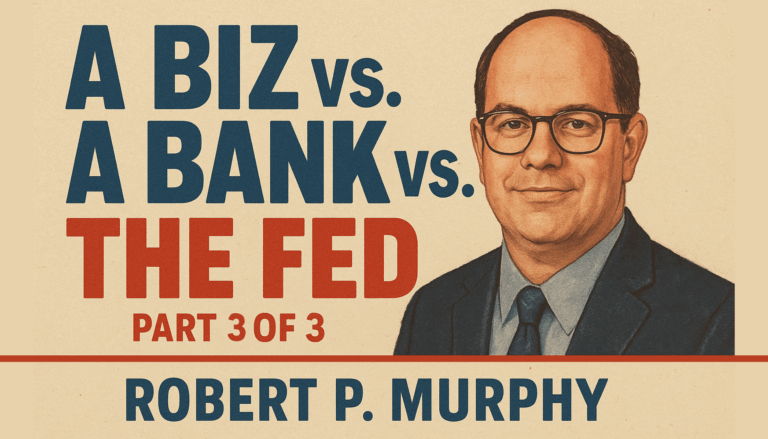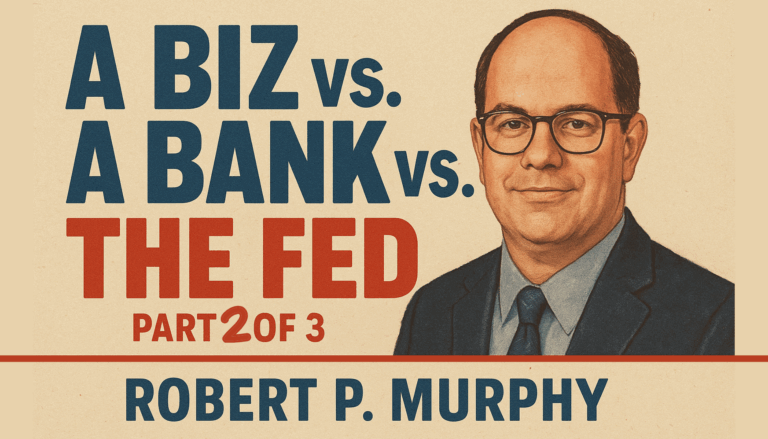In a previous post, I began this 3-part series in response to a Tucker Carlson interview with economist Richard Werner, author of the provocative Princes of the Yen and coiner of the term quantitative easing (QE). One theme of the interview was Werner’s revelation to a surprised Tucker that private banks “create money” in our current financial system, indeed (he claimed) creating far more money than central banks/governments. Although I agree with Werner that private banks can create money in a way that a conventional business (like Tesla) cannot, I noticed that on social media, many of his supporters took the claim too far, and seemed to believe that private banks were on the same footing—at least vis-à-vis their ability to create money—as central banks. I thus set out on this 3-part series to show why private banks (like Citibank) are not as powerful as central banks, like the Federal Reserve or the Bank of Japan.
Now in that Part 1 of the series, I methodically showed the balance sheets of Tesla and then Citibank, as each of them effectively borrowed $100,000 from a household (“Jim Smith”) in order to make a $100,000 loan to a solar panel company. I pointed out that there was a critical difference in the two scenarios: When Tesla made a loan, the total size of its balance sheet remained the same; its cash (specifically, checking account balance) went down by $100,000 while its IOU from the solar panel company became a new asset worth $100,000 at the moment of the loan. In contrast, when Citi made the loan, Citi’s vault cash didn’t go down (at least not at the precise moment the loan was granted), but its liabilities went up, in the form of an extra $100,000 credited to the Citi checking account held by the solar panel company.
I then jumped ahead a year, to show what happened to Citi’s balance sheet when the solar panel company paid back the loan and Jim Smith withdrew his original deposit. But I mentioned in that Part 1 that I had left out some critical details, which would be necessary to understand in order to fully appreciate the limited power of Citi to “create money.” It is this filling in of the details—spelling out what happens during the year after Citi grants the loan but before it’s paid back—that I aim to accomplish in this present post, Part 2. (Finally, in the forthcoming Part 3, I will show what happens when the Federal Reserve decides to make loans, and how that’s qualitatively different from Citi’s operations.)
Review from Part 1: The Evolution of Citi’s Balance Sheet
Obviously, the present post will only be comprehensible to those who have first read Part 1. Yet even for those who have already read it, it will be helpful to reproduce below the segment of the prior discussion, where I summarize the way in which Citi takes a deposit from Jim Smith and then parlays it into a one-year loan to the solar company:
Suppose we start with Citi, a private-sector company (i.e. not an official vessel of the government) that is a commercial bank. Assume it starts with $1 million in shareholder equity. Its customer, Jim Smith, hands over $100,000 of his saved money to Citi, and begins earning 5 percent (which we assume is the yield on his checking account with Citi). Immediately afterward, Citi also advances a loan of $100,000 to the solar company, charging 8%.
Then we jump ahead a year. Jim Smith decides to pull his money out in the form of currency, while PanelsRUs has made enough sales and deposits to replenish its own checking account enough to pay back the loan to Citi. Here are the details:
Snapshot 1, September 1, 2025, 12pm: Citi original position
|
Assets |
Liabilities + Shareholder Equity |
|
Vault cash: $1,000,000 |
Liabilities (none) Equity $1,000,000 |
|
TOTAL ASSETS: $1,000,000 |
TOTAL LIABILITIES + EQUITY: $1,000,000 |
Snapshot 2, September 1, 2025, 1pm: Jim Smith deposits $100,000 of cash into his checking account, which has APY of 5%
|
Assets |
Liabilities + Shareholder Equity |
|
Vault cash: $1,100,000 |
Liabilities Jim Smith checking acct balance: $100,000 Equity $1,000,000 |
|
TOTAL ASSETS: $1,100,000 |
TOTAL LIABILITIES + EQUITY: $1,100,000 |
Snapshot 3, September 1, 2025, 2pm: Citi lends $100,000 at 8%
|
Assets |
Liabilities + Shareholder Equity |
|
Vault cash: $1,100,000 PanelsRUs 8% Bond held by Citi: $100,000 |
Liabilities Jim Smith checking acct balance: $100,000 PanelsRUs checking acct balance: $100,000 Equity $1,000,000 |
|
TOTAL ASSETS: $1,200,000 |
TOTAL LIABILITIES + EQUITY: $1,200,000 |
Then a year passes, and the following transaction occurs:
Snapshot 4, September 1, 2026, 1pm: PanelsRUs pays Citi $108,000 to redeem its bond.
|
Assets |
Liabilities + Shareholder Equity |
|
Vault cash: $1,108,000
|
Liabilities Jim Smith checking acct balance: $105,000 PanelsRUs checking acct balance: $0 Equity $1,003,000 |
|
TOTAL ASSETS: $1,108,000 |
TOTAL LIABILITIES + EQUITY: $1,108,000 |
To reiterate, the above balance sheets and (abbreviated) commentary are reproduced from Part 1. What I want to do now, is spell out what happened during the year, which I glossed over before (partly because of space constraints but also because of the point I was trying to make in Part 1).
What Happened to Citi’s Balance Sheet During the Year?
The fundamental limitation of a private commercial bank (such as Citi) is that, although it can “create dollars” in onesense, it can’t create dollars that are legally or economically equivalent to Federal Reserve Notes. In other words, it is legally and economically a different thing to hold ten $100 bills (meaning green rectangles with pictures of Ben Franklin) rather than to have a deposit slip from Citi showing you have $1,000 in your checking account with them. If you doubt that these are truly different things, then ask yourself: What happens during a bank run?
Because of this fundamental difference, Citi has to be careful when granting loans. In our example, after making the $100,000 loan to PanelsRUs, let’s see what happens if the company writes checks on its Citi account, and it happens to buy supplies from firms who are not clients of Citi. To keep the story simple, suppose PanelsRUs writes one check for the full $100,000 to a supplier who happens to bank with Wells Fargo.
In this case, PanelsRUs sees its deposit with Citi go from $100,000 to $0. The supplier sees its account with Wells Fargo rise by $100,000. But also, Wells Fargo now has a claim on Citi for $100,000. The equity (or solvency) of each bank is unaffected; Citi’s liabilities merely got shifted, with $100,000 owed to PanelsRUs being instead owed to Wells Fargo, while Wells Fargo’s assets went up by $100,000 (its claim on Citi) but its liabilities also went up by $100,000 (its client now has that much more in its checking account with Wells Fargo).
Although private commercial banks might be willing to allow their net liabilities from one to the other fluctuate to facilitate commerce among their clients, at some point they will want to “settle up” after the dust settles from the clearinghouse operations. To continue our story, suppose that after one week, Wells Fargo requests that Citi honor its $100,000 obligation. In the real world, this could be satisfied by transferring reserve balances with the Fed, but we’ve intentionally kept central banks out of our tale so far. At this point, Citi’s reserves consist of vault cash, and so they put $100,000 into an armored vehicle and drive it over to Wells Fargo, where the employees put it safely into their vault.
After this clearinghouse settlement occurs, we look at Citi’s balance sheet. (And note that I’m calling it Snapshot 3.5, and dating it to occur in between Snapshots 3 and 4 from above.)
Snapshot 3.5, September 8, 2025, 2pm:
Because PanelsRUs wrote a check for $100,000 to a client of Wells Fargo, Citi must send $100,000 in cash to Wells Fargo.
|
Assets |
Liabilities + Shareholder Equity |
|
Vault cash: $1,000,000 PanelsRUs 8% Bond held by Citi: $100,000 |
Liabilities Jim Smith checking acct balance: $100,000 PanelsRUs checking acct balance: $0 Equity $1,000,000 |
|
TOTAL ASSETS: $1,100,000 |
TOTAL LIABILITIES + EQUITY: $1,100,000 |
As this simple example illustrates, reserves do matter, even in a financial system where private banks can create money merely by extending credit. Furthermore, notice that I didn’t say anything about official “reserve requirements” (which were abolished in the US in 2020).
Even though Citi didn’t need to rely on its vault cash when it originally granted the loan to PanelsRUs—and this is why many of Werner’s fans insist that nowadays bank reserves are irrelevant or a red herring—the amount of vault cash was still important. If, say, Citi had granted PanelsRUs a loan of $100 million, then even just spending a fraction of it on people who banked elsewhere, could spell disaster for Citi.
The Lesson
A private commercial bank that operates with “fractional reserves”—meaning the total amount of its customers’ checking account balances is higher than the amount the bank has in vault cash and/or reserves with the Fed—is inherently vulnerable. Its business model relies on a maturity mismatch, where it borrows short and lends long. The only reason a commercial bank can get away with “creating money” in a way that Tesla can’t, is that the community treats IOUs issued by Citi as being interchangeable with currency, at least during normal times. (In contrast, you can’t use a Tesla bond to buy groceries or pay your landlord.)
However, that equivalence evaporates the moment a bank is unable to convert its obligations into the underlying base money upon demand. If Jim Smith walks into a Citi branch and wants to withdraw $1,000 from his checking account—which Citi claims stands at $100,000—and the teller informs him, “Sorry sir, our vault is running a little dry right now, can you come back next week?” then the jig is up. Word will spread that Citi is in trouble, and then a bank run will become a self-fulfilling prophecy.
During his Tucker interview, Werner cast aspersions on the old textbook fractional reserve story, whereby each bank would lend out (say) 90% of the amount that someone deposited. For example, if Jim Smith deposits $100,000, then maybe the bank only makes a loan of $90,000 to someone else, and then when that money finds its way into a different bank, that bank makes a new loan of $81,000, and so on. Werner is correct that there’s nothing in financial regulations preventing banks from operating more aggressively. But the reason for that old textbook story, is that banks do have to proceed cautiously, since each private bank only has so much market share. Whenever a bank’s client writes a check to a client of a different bank, that transaction racks up a gross claim on the original bank, where the final (net) claims are settled via reserve transfers.
Now that we’ve spelled out the limitations on private bank money creation via loans, in Part 3 we can show why the Fed’s constraints are far weaker.
Dr. Robert P. Murphy is the Chief Economist at infineo, bridging together Whole Life insurance policies and digital blockchain-based issuance.
Twitter: @infineogroup, @BobMurphyEcon
Linkedin: infineo group, Robert Murphy
Youtube: infineo group
To learn more about infineo, please visit the infineo website

